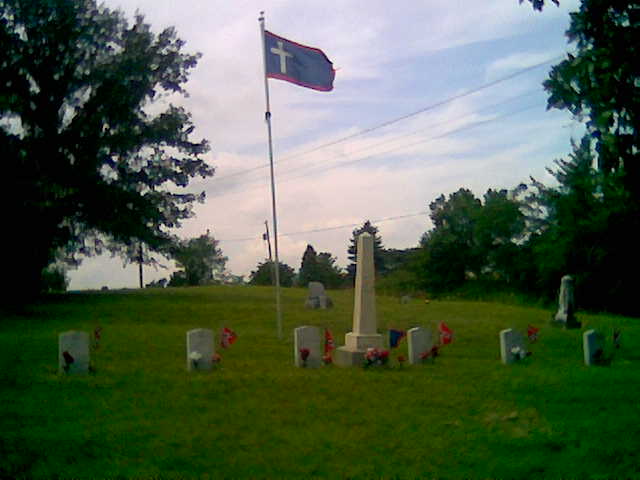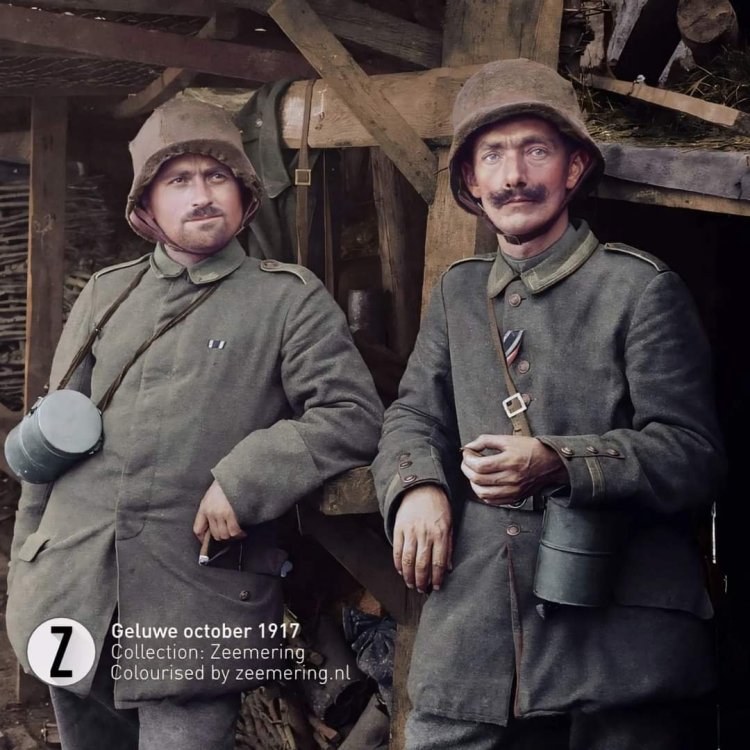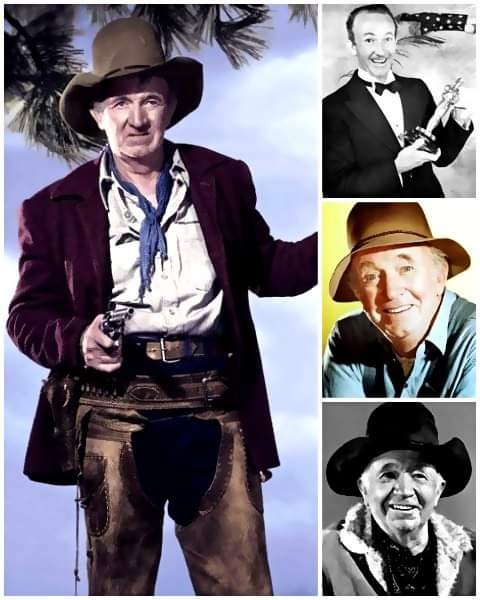-
Posts
47,526 -
Joined
-
Last visited
-
Days Won
593
Content Type
Profiles
Forums
Events
Everything posted by Subdeacon Joe
-

Kulturgeschichte and Geistesgeschichte
Subdeacon Joe replied to Subdeacon Joe's topic in SASS Wire Saloon
Well said. -
My wife said, "Oooo...deviled eggs!"
-
That would be killer on a roast beef or roast pork sandwich.
-
German soldiers wearing rare Hessian helmet covers posing for a photograph in a trench, October 1917. . Colourised by Zeemering historic photo colourisation and restoration . The following is Danish-German soldier Peter Rossen's diary entry from the front at Berry-au-Bac, reporting on an incident while fetching water from a pump in April 1916. Translated by myself: ⠀⠀⠀⠀⠀⠀⠀⠀⠀⠀⠀⠀ "I went home on leave in April 1916 for Easter, the only holiday I spent at home in those 4,5 years. We were taking turns to fetch water for the field kitchen, and on the evening I was going home, it was my turn to do it. This evening the shelling was particularly hefty. . We fetched the water by a farm which was blown to ruins. Here was a small pump, but it took a long time to fill the bucket. It was uncomfortable that the farm was shelled at intervals. . We were to get to the pump in between the shellings. I had been jumping back and forth between cover and pump a few times already, and on this evening they fired more than usual. . A comrade from Mecklenburg approached me and said: "I'll take over for you now, because you have a family at home who awaits you. I'm alone and no one would mourn for me." . I had once written an application for leave for him and it had been accepted; now he wanted to repay the favour. . That was what the camaraderie was like." . #worldwar1 #wwi #ww1 #firstworldwar #worldwarone #thegreatwar #history #militaryhistory #ww2 #wwii #worldwar2 #worldwarii
-
When your HOA complains about everything, so you decide to roll your project vehicle out of the garage and really give them something to get riled up over.
-
Here's an engine rarely seen since they were intended to be disposable. This is the 4 cylinder radial engine from a WWII German G7A torpedo. It ran on Decaline fuel (decahydronaphthalene), which was first burned using compressed air (stored in a tank onboard) as an oxidizer. The combustion byproducts were then passed through a device called a 'wet heater', which also introduced water (from a 57L storage tank) to produce superheated steam. This high pressure mixture of superheated steam and compressed air was finally sent through the engine to drive the pistons. Since the entire internal combustion/steam generator system was self-contained inside the hull of the torpedo, it could run underwater. The 4 cylinder, 'X' type radial engine produced up to 350 horsepower at its maximum power setting, which was enough to push the 26' (just over 7 meters) torpedo (the length of a large Uhaul moving van here in the States for comparison purposes) along at nearly 50mph while submerged. Interesting piece of history-and worth remembering-in my opinion. Dwelle and 40K others
-
-
Most likely. It's the first one after that. I think so: (found in one of the FB comments)
-
-
-
What was it doing with your shoe?
-
-
Death Valley Hiking & Adventure · Just outside western entrance to Park along 190 near Darwin turnoff at 8:30 this morning!
-
I guess it beats honest work. Intellectual History As a field of intellectual enquiry, the history of ideas emerged from the European disciplines of Kulturgeschichte (Cultural History) and Geistesgeschichte (Intellectual History) from which historians might develop a global intellectual history that shows the parallels and the interrelations in the history of critical thinking in every society.[2][3] Likewise, the history of reading, and the history of the book, about the material aspects of book production (design, manufacture, distribution) developed from the history of ideas. The concerns of intellectual history are the intelligentsia and the critical study of the ideas expressed in the texts produced by intellectuals; therein the difference between intellectual history from other forms of cultural history that study visual and non-verbal forms of evidence. In the production of knowledge, the concept of the intellectual as a political citizen of public society dates from the 19th century, and identifies a man or a woman who is professionally engaged with critical thinking that is applicable to improving society. Nonetheless, anyone who explored his or her thoughts on paper can be the subject of an intellectual history. For instance, The Cheese and the Worms (1976), Carlo Ginzburg's study of the 16th-century Italian miller Menocchio (1532–1599) and his cosmology, falls within the genre of intellectual history (as well as cultural history, the history of mentalities, and microhistory).[4] The Journal of the History of Ideas is one of the flagship journals in intellectual history.
-
Other Shooter: "These Sights Are Off!" Me: "May I try it?" bang, bang bang....."Nope, they're on, you are flinching." OS: "I don't flinch!" Me(calmly reloading magazine and putting in a random snap cap) : "Here, try again." OS: Bang, Bang, Bang, CLICK! (with gun pointing at the ground 5 feet in front of him) "Oh......."
-
This is Jackie Moggridge, she ferried 1,438 planes to waiting RAF pilots during WW2, flying dozens of aircraft types. At 5’3” she was too small for many planes that were designed for men, and would use her parachute, log books and cushions just so she could reach the controls. Jackie was awarded the King’s Commendation for Valuable Services in the Air after the war and was determined to continue flying. From 1948-1954 she was a pilot in the Women’s Royal Air Force Voluntary Reserve, where in 1953, she was one of the first five women to earn their RAF wings. The next woman would not earn her wings until 1991. #raf #pilot #ww2
- 1 reply
-
- 5
-

-

-
Under Gun Turret For Lancaster Bomber. ✦ #helicopters #airbus #bell #usa #war #hughes #technology #military #WWII #aircraft #airshow #aviation #pilot … See more
- 1 reply
-
- 1
-

-
Local 767 was located at 1710 S. Central Avenue, Los Angeles, CA 90021 The life of the Los Angeles jazz musician often revolved around the headquarters of their local, all-black musician’s union, founded in 1920. “A gathering place for generations of musicians,” according to The Dark Tree, “767 also served as a social and cultural center and offered a range of activities from casual affairs to barbeques and parades.” Not only did the union help jazz musicians get jobs and negotiate pay and contracts, it was also “a favorite hangout for young aspiring artists who wanted to be part of the scene and meet their heroes.” In upstairs rehearsal spaces, young musicians would often simply walk in and listen to superstars like Duke Ellington rehearse. They were encouraged to ask questions, and occasionally sit in and jam. “Every black musician in the world would pass by there, slap you upside the head, and say something smart to you,” Horace Tapscott recounted in The Dark Tree. “Me…and the other young guys were sitting there all the time, during all those years… It was just rich, very rich.” As stated by Tony Valdez, truth be told, Local 767 existed because members of the American Federation of Musicians Local 47 were all White people, a majority of whom wanted to keep it that way. The de facto segregation of musicians ended on April 1, 1953 with the “amalgamation” of the two locals. Gerald Wilson, Buddy Collette and Ernie Freeman were among the many who struggled for equality and fairness at all the live music venues in Southern California.
-
Nope....that was your suggestion, sir, by bringing in AAVE. I obviously consider it a normal part of everyday English, even if shunned by "proper" society.
-
https://www.youtube.com/watch?v=Sj4tEj5aV7c
-
Walter Brennan: The Voice and Heart of Hollywood's Golden Era - Walter Brennan, with his distinctive voice and everyman demeanor, carved a niche in Hollywood's golden era, leaving an indelible mark on the silver screen. Have you ever wondered about the journey of actors who seem to have always been part of the cinematic landscape, as familiar as the stories they help tell? Brennan's story is one of those, a tale not just of talent, but of perseverance, adaptability, and a knack for bringing depth to every role. Born in Lynn, Massachusetts, in 1894, Walter Brennan's early life did not immediately point towards the glitz and glamour of Hollywood. The son of Irish immigrants, his upbringing was modest, rooted in the values of hard work and resilience. Before venturing into acting, Brennan's life was as varied as the roles he would later play, including stints as a bank clerk and serving in the U.S. Army during World War I. It was after the war, with the United States in the throes of change and the film industry beginning to flourish, that Brennan found his calling in acting. Making his debut in the 1920s, Brennan's entry into Hollywood was through the silent film era, a time when the industry was burgeoning, and talkies were just on the horizon. His transition from silent films to sound films was seamless, a testament to his versatility and skill. Initially, he found work as an extra, gradually moving to more substantial roles as his talent became evident. The career of Walter Brennan is a treasure trove of cinematic gems, spanning over decades and encompassing a variety of genres. From the 1930s through the 1960s, he became a familiar face, known for his roles as lovable, often gruff, old men. His filmography during these years is impressive, featuring classics such as "Come and Get It" (1936), for which he won his first Academy Award, "Kentucky" (1938), and "The Westerner" (1940), showcasing his range and depth as an actor. Brennan's ability to imbue each character with authenticity made him a favorite among directors and audiences alike. His accolades are a reflection of his impact on the film industry. Walter Brennan is one of the few actors to have won three Academy Awards for Best Supporting Actor, a feat that speaks volumes about his talent and the respect he garnered among his peers. These awards, for "Come and Get It," "Kentucky," and "The Westerner," underscore his unique ability to bring characters to life in a way that was both relatable and captivating. Beyond the silver screen, Brennan's personal life was as grounded and intriguing as the characters he played. Married to Ruth Wells, their life together was marked by a shared love of the outdoors and horse breeding, interests that kept him connected to the simple pleasures of life. This personal passion for the natural world often mirrored the rugged, earthy characters he portrayed, adding layers to his performances that felt both genuine and deeply human. Walter Brennan's influence extended beyond his roles in front of the camera. With a career that spanned over four decades, he witnessed and contributed to the evolving landscape of the American film industry. His work in television, particularly in the series "The Real McCoys," further cemented his legacy as a versatile actor capable of crossing the divide between cinema and early television. Walter Brennan passed away on September 21, 1974, in Oxnard, California. His departure marked the end of an era but also the celebration of a life that had profoundly impacted the entertainment industry and audiences around the world. His legacy, carried by an impressive body of work, continues to inspire and entertain, proving that genuine talent and authenticity never fade. Reflecting on Brennan's journey, it's clear that his success was not just a product of talent, but of an enduring commitment to his craft. His story is a reminder of the power of resilience, the beauty of versatility, and the impact of authenticity. In a world constantly seeking connection and depth, Brennan's performances continue to resonate, offering a window into the human experience that is as relevant today as it was during Hollywood's golden age. So, next time you watch one of his films, take a moment to appreciate the man behind the character. Think about the paths he walked, both on and off the screen, and consider the legacy of an actor who, through his diverse body of work, invites us to see the world through a broader, more compassionate lens. Isn't it fascinating how the stories we love can be doorways into understanding the complexities of life and the enduring spirit of those who help tell them?




